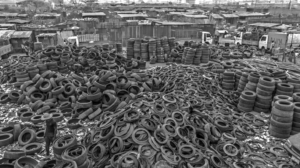A truly global, omniscient commodity and a symbol of humanity’s historic dependency on motor vehicles, in contexts such as African mega-cities, tyres epitomize the resilience and creativity of urban everyday life. As one of our preliminary informants told us: ‘In Nigeria, a tyre never dies’. And, as environmentalist and Guardian journalist George Monbiot pointed out, the problem of end-of-life tyres (ELTs) recycling, largely ignored in policy circles and green agendas, constitute a truly global challenge with huge implications in terms of health and well-being.
Our project addresses the need to respond to this pressing global environmental challenge affecting African mega-cities and has the potential to be applicable to many urban contexts of the African continent and beyond, where, as in Lagos, the abundance of ELTs reflects pressures on urban and transport infrastructure and the over-reliance, born of necessity, upon automobiles. However, while the presence of used/waste tyres in the urban landscape has detrimental environmental consequences, it is also at the heart of a thriving—mostly informal—roadside economy of small garages and vulcanisers as well as an upcycling sector through which tyres are repurposed in many ways.
Our most fundamental research question is: How can an interdisciplinary approach provide a productive response to determining the complex relationships between waste and well-being in the re-use of tyres across economic, infrastructural and social domains of the mega-city?

The major aims of the project are:
- To study the social, gendered, technical and cultural implications of processes of ‘pneumatic crafting and recrafting’ with a view to understand the opportunities of an emerging circular urban economy.
- To explore the trajectories of tyre-use into still more informal spheres of crafting urban environments. These two approaches permit us to examine relations between well-being and waste in different urban domains of activity.
- To provide environmental assessments adapted to a diversity of urban ecologies of ELTs and to suggest comparative methodologies and metrics for application in other mega-cities within and beyond Africa.
- To identify gaps in the supply chain, with the potential to indicate how coordination can be improved between different actors and stakeholders including roadside workers (eg vulcanisers), waste management practitioners and tyre recycling/upcycling operators.
- To develop and disseminate the concept of ‘frictional infrastructures’, which, we suggest, refer to infrastructures and economies that exist as an interface between formal infrastructures and the public, or at the intersection of formal and informal economies and shape the socio-materiality of complex and often resilient urban assemblages. This mediating aspect and frictional property of infrastructure has so far been scantily researched.
In exploring the material and social balance between waste and well-being, we aim to trace the social and economic significance of re-use of tyres while assessing the environmental effects of this category of infrastructure as it makes the journey from formal to informal domains of use.
More information on the British Academy ‘Urban Infrastructures of Well-Being’ research programme can be found here
